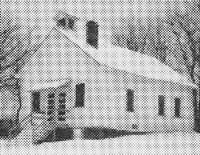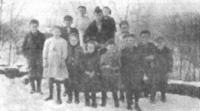
Bethel School
in Berlin Township,
built in post-Civil War period, restored in 1977. It is
now a historic and educational attraction for tourists and
Wayne County students.

Students and Teacher, Hiawatha
School,
Scott Township, circa 1914
Questionnaire for Rural
School
Teachers
From Public Schools of
Wayne County, Pennsylvania,
1917
1. Is the welfare
of your
school your first concern?
2. Do you make daily
preparation
for teaching?
3. Are you interested
in
the general welfare of your pupils?
4. Are you making an
effort
to become acquainted with your patrons?
5. Do you subscribe
for
and read an up-to-date teachers' magazine?
6. Are you in the
habit
of reading a good text on Methods and School Management?
7. Do you talk school
matters
with your associates and co-workers?
8. Do you look after
the
sanitary conditions of your school property?
9. Do you allow
pupils
to litter the school room and grounds with waste paper, apple cores,
etc.?
10. Do you allow dust
to
accumulate in the nooks and corners of your school room?
11. Do you throw the
ashes
in a heap in front of the school house?
12. Do you know how
to
build a fire and keep a school room in a comfortable condition?
13. Do you inspire
your
pupils to read good books?
14. Are you
interested
in rural life?
15. Are you
optimistic?
16. Does your school
have
access to periodicals containing brief discussions of current events?
17. Has your school a
library?
18. Do you show skill
in
the application of primary methods and devices?
19. Are you making an
attempt
to instill in the minds of the pupils local pride and local patriotism?
Beere School Photo  8-20-05
8-20-05
THERE IS A ROOM-LIKE VAULT located on an interior wall of the Wayne County Historical Society's main Museum on Main Street in Honesdale. Once used as a room for conducting business, this "vault" is now used for computer terminal space and historical research, among other activities. Recently, it has become the temporary "office" of Mimi Steffen of Rileyville, who has taken on the task of creating a computer database of all persons who taught in the schools of Wayne County up to the year 1945.
Mimi has been sitting at a computer terminal in this vault hour after hour, day after day, for several months, in an effort to input the data about Wayne County's former teachers. She has been obtaining information from a wide variety of sources. Commenting on her research, Mimi said: "Several of my ancestors taught in the Wayne County schools. When I searched for the names of schools in which they taught or the years in which they taught, the search was frustrating. Information seemed to be scattered throughout the county, in the courthouse and the various historical societies."
Believing it would be helpful to have all of this information accessible in one central place, Mimi set up a database with the help of Society trustee and genealogical researcher Ann O'Hara. It contains all appropriate information about each teacher, including: name, dates, school, assignment, township, specific location of school, residence of teacher, certification, salary, location of original information source, and site of information source.
TYPICAL FILE
As of this writing, Mimi has input the names of over 2,000 individuals who have taught in Wayne County schools, but the research is far from complete. Her sources go back as far as 1828 to a teacher named Lewis Pestane, who taught in Honesdale. To illustrate the contents of a typical file in the database, Mimi retrieved the data on her mother, Ada Doherty, who taught at Lalburette School in Lebanon Township, Route 4019. Ada taught there from September 1906 until April 1907. Her pay was $105 for the term. This information is contained in a "ledger book" at the Equinunk Historical Society. But there is no information about the type of certificate Ada held or her residence. Different sources give different types of information, and some of the "missing" information may have been destroyed or thrown out over the years because it was not thought to be important by the local township secretaries or former school boards.
TEACHERS' INSTITUTE
One of Mimi's more important research sources is the yearly listing of teachers who attended the annual Wayne County Teachers' Institute. The Institute convened each fall in late October or early November for a full week in Honesdale. The children would have a week's vacation while teachers attended lectures and workshops on the latest educational topics. When teachers in attendance registered at the annual Institute, each individual provided the residence of theteacher and the name of the school. Sometimes as the teacher would register, the colloquial school name was given rather than the formal name. Other times only the number of the school was given by the teacher. For example, Rileyville was the first school established in Lebanon Township; it might be known as School No. 1. If the township was not listed by the teacher, figuring out in which township the school was located can be problematic or sometimes impossible for the researcher.
PROMINENT NAMES
Occasionally, in making data entries Mimi would come across prominent Wayne County names. Jennie Brownscombe was one. She was an internationally acclaimed artist and native of Honesdale. This year, Brownscombe is the subject of a Historical Society exhibit: "Jennie Brownscombe: Wayne County's Own." Jennie taught in the Honesdale schools in 1868 and for several other terms to earn money so she could attend art school. Another familiar name Mimi discovered was Edith Firmstone, who happens to be one of Mimi's fellow bridge players. Edith taught at the Lincoln School where she was assigned to the "extra room." She said that when a classroom was at capacity, any student enrolling thereafter would be put in the "extra room." Thus, although Lincoln School supposedly had students in only one grade in each classroom, the "extra" teacher might have up to three grade levels. Among other prominent names was the teacher couple, Maurice Meagher and his wife Margaret 0'Neill Meagher. The Meaghers taught in several Wayne County schools over long careers.
VACATIONS AND LUNAR CALENDARS
The
research is
also shedding light on many other aspects of education in Wayne County.
For instance, why do we have such long summer vacations for school
children?
The children lose so much academically with almost three months off
each
summer. In the fall, a teacher must spend a month or so reviewing what
the students have forgotten. We think we all know the
answer: 'The rural schools had
to
adjust to an agrarian society. In the summer the children were needed
at
home to help with the having." This has been shown to be incorrect. In
the late 1800's there was actually a summer term at some county
schools,
usually extending from early June until the end of August.
And oddly, some school sessions were based on the lunar calendar. Yes, the attendance period recorded in the ledger book might begin on the fifth of September and continue until the second of October. The ledger books specifically say "Lunar Month." Mimi asks if anyone can suggest a reason for the lunar calendar in a ledger book. Research often brings surprises. But what was Mimi's biggest surprise? Numbers. Big ones.
PACKING THEM IN
Class sizes in one-room schoolhouses, Mimi found, were sometimes incredibly large. In most instances, it happened because of the influx of German and Irish immigrants, who came to work on the canal in the 1800's. They had children—lots of them. And they had to be educated. Which prompted Mimi to ask: "Remember those stories of one-room schools with fifteen or twenty pupils?" And she supplied her own answer: "Yes, there were many such schools throughout the county. But how about 80 or 90 pupils in all grades with one teacher!"
Mimi's
research turned
up data on one teacher, F. P. Galpin, who at times had as many as 92
pupils.
It is not known if the teacher was male or female.
Galpin's salary was $40 a
month
for the winter term of 1877. Her (or his) class size averaged 76 pupils
per month. Ledger books do not provide us with reasons, but during the
fall term of 1877, Galpin's salary dropped to $28 a month and stayed
there
until the following fall when it returned to $40 a month. Enrollment
for
the lunar month January 13 to February 12,1877, peaked at 92. Entries
in
the ledger book also allow tracking the ingress and egress of pupils,
who
were entering and leaving at a regular pace. For example, in that same
January and February, three boys left and eight girls enrolled. The
school
was called the Genung Hill School and was located at the intersection
of
what is now Iterrace Street and Green Street, not far from present-day
Honesdale High School. And how big was this schoolhouse? If it was the
same size as most one-room schools, as typified by Wayne County's
preserved
Bethel School, there would be httle elbow room. More questions than
answers
come from this part of Mimi's research, such as: Would the school
even pass today's occupancy fire code?
As for F. P. Galpin, Mimi says, "Perhaps this teacher can be given some kind of an award posthumously. How was this teacher able to deal with students in eight different grades, with possibly an age difference of ten years, and an ever changing pupil mix? I am in awe!"
INVALUABLE CONTRIBUTION
Spin-off
projects from
Mimi's research have already begun, such as a new exhibit at the Museum
featuring the location of the small country schools of
Wayne County, and an effort to
find
photographs of as many of these small schools as possible. Those who
are
present while Mimi conducts the slow and methodical entry of data into
the database are amazed at the proportions of the project and her
perseverance.
When completed, it will stand as an invaluable collection of data from
all parts of Wayne County, and it will continue to shed light on the
history
of education in this corner of Northeastern Pennsylvania.
If you or one of your ancestors taught in Wayne County prior to 1945, the Wayne County Historical Society is actively seeking photographs of and information about teaching conditions in these small country schools. If you have information to share, please contact the Society. Photos will be copied and originals returned to the owner.
ACKNOWLEDGMENT
Without Mimi Steffen's research and friendly forthcoming nature, this could not have been written. CHD.